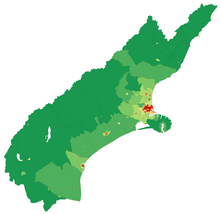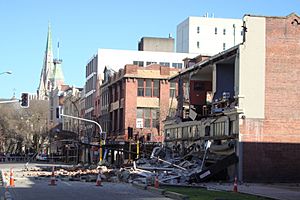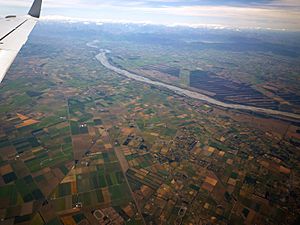Canterbury Region facts for kids
Quick facts for kids
Canterbury
Waitaha (Māori)
|
|
|---|---|
|
Region of New Zealand
|
|
| Canterbury Region | |
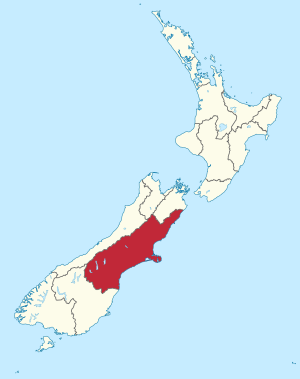
Canterbury Region in New Zealand
|
|
| Country | New Zealand |
| Island | South Island |
| Established | 1989 |
| Seat | Christchurch |
| Territorial authorities |
List
Kaikōura District
Hurunui District Selwyn District Waimakariri District Christchurch City Ashburton District Mackenzie District Timaru District Waimate District Waitaki District (59.61%) |
| Government | |
| • Body | Canterbury Regional Council |
| Area | |
| • Land | 44,503.60 km2 (17,182.94 sq mi) |
| Population
(June 2023)
|
|
| • Region | 666,300 |
| Demonym(s) | Cantabrian |
| GDP | |
| • Total | NZ$ 44.032 billion (2021) |
| • Per capita | NZ$ 67,400 (2021) |
| Time zone | UTC+12 (NZST) |
| • Summer (DST) | UTC+13 (NZDT) |
| HDI (2021) | 0.938 very high · 4th |
Canterbury (Māori: Waitaha) is a region of New Zealand, located in the central-eastern South Island. The region covers an area of 44,503.88 square kilometres (17,183.04 sq mi), making it the largest region in the country by area. It is home to a population of 666,300 (June 2023).
The region in its current form was established in 1989 during nationwide local government reforms. The Kaikōura District joined the region in 1992 following the abolition of the Nelson-Marlborough Regional Council.
Christchurch, the South Island's largest city and the country's second-largest urban area, is the seat of the region and home to 58 percent of the region's population. Other major towns and cities include Timaru, Ashburton, Rangiora and Rolleston.
Contents
History
Natural history
The land, water, flora, and fauna of Canterbury has a long history, stretching from creation of the greywacke basement rocks that make up the Southern Alps to the arrival of the first humans. This history is linked to the solidification and development of tectonic plates, the development of oceans and then life itself.
The region is a part of the larger Zealandia continent, itself a part of the larger Australian and Pacific tectonic plates. In the first instance, the land is based upon the constructive tectonic forces of this convergent and transformational tectonic plate boundary. In the second instance, the erosive forces of rain, snow, ice, and rock grinding against rock have developed large gravel fans that extend out from the mountains. In the third instance, there is volcanism punching through the basement rocks and blanket of sediments to the surface. Upon this solid foundation, and slowly over the billions of years, life made up of a countless generations of interconnected adaptations developed into the unique flora and fauna of Aotearoa/New Zealand. The remnants populations of these unique species are visible today in the publicly protected conservation lands.
The species of Waitaha/Canterbury were adapted to the climate and geography that traverses inland from the coastline to the highest peaks, and from the warmer climes in the north to the colder in the south.
Before European settlement
Canterbury has been populated by a succession of Māori peoples over the centuries. When European settlers arrived, it was occupied by Ngāi Tahu, whose numbers had been greatly reduced by warfare, among themselves and with Te Rauparaha and his Ngāti Toa from the North Island, in the early 19th century.
Colonisation
In 1848, Edward Gibbon Wakefield, a Briton, and John Robert Godley, an Anglo-Irish aristocrat, founded the Canterbury Association to establish an Anglican colony in the South Island. The colony was based upon theories developed by Wakefield while in prison for eloping with a woman not-of-age. Due to ties to the University of Oxford, the Canterbury Association succeeded in raising sufficient funds and recruiting middle-class and upper-class settlers. In April 1850, a preliminary group led by Godley landed at Port Cooper – modern-day Lyttelton Harbour / Whakaraupō – and established a port, housing and shops in preparation for the main body of settlers. In December 1850, the first wave of 750 settlers arrived at Lyttelton in a fleet of four ships.
Following 1850, the province's economy developed with the introduction of sheep farming. The Canterbury region's tussock plains in particular were suitable for extensive sheep farming. Since they were highly valued by settlers for their meat and wool, there were over half a million sheep in the region by the early 1850s. By the 1860s, this figure had risen to three million. During this period, the architect Benjamin Mountfort designed many civic and ecclesiastical buildings in the Gothic Revival style.
Canterbury Province
The Canterbury Province was formed in 1853 following the passing of the New Zealand Constitution Act 1852. It was formed from part of New Munster Province and covered the middle part of the South Island, stretching from the east coast to the west coast. The province was abolished, along with other provinces of New Zealand, when the Abolition of the Provinces Act came into force on 1 November 1876. The modern Canterbury Region has slightly different boundaries, particularly in the north, where it includes some districts from the old Nelson Province.
2010–2011 earthquakes
September 2010
A magnitude 7.1 earthquake occurred in the region on Saturday 4 September 2010, at 04:35 am. The epicentre was located 40 kilometres (25 mi) west of Christchurch; 10 kilometres (6.2 mi) south-east of Darfield, and had a depth of 10 kilometres (6.2 mi). The earthquake caused widespread damage to buildings and power outages, but no direct fatalities. Sewers were damaged, gas and water lines were broken, and power to up to 75% of the city was disrupted. Christchurch residents reported chimneys falling in through roofs, cracked ceilings and collapsed brick walls.
A local state of emergency was declared at 10:16 am on 4 September for the city, and evacuations of parts were planned to begin later in the day. People inside the Christchurch city centre were evacuated, and the city's central business district remained closed until 5 September. A curfew from 7 pm on 4 September to 7 am on 5 September was put in place. The New Zealand Army was deployed to assist police and enforce the curfew.
There were 63 reported aftershocks in the first 48 hours, with three registering 5.2 magnitude. The total insurance costs of the event were estimated as up to $11 billion, according to the New Zealand Treasury.
February 2011
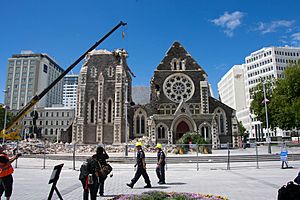
A large aftershock of magnitude 6.3 occurred on 22 February 2011 at 12:51 pm. It was centred just to the north of Lyttelton, 10 kilometres south-east of Christchurch, at a depth of 5 km. Although lower on the moment magnitude scale than the quake of September 2010, the intensity and violence of the ground shaking was measured to be VIII on the MMI, which is among the strongest ever recorded globally in an urban area due to the shallowness and proximity of the epicentre.
The quake struck on a busy weekday afternoon. This, along with the strength of the quakes, and the proximity to the city centre, resulted in 181 deaths. Many buildings and landmarks were severely damaged, including the iconic Shag Rock and Christchurch Cathedral. New Zealand's first National State of Emergency was promptly declared.
June 2011
On 13 June 2011 at about 1:00 pm New Zealand time, Christchurch was rocked by a magnitude 5.7 quake, followed by a magnitude 6.3 quake at 2:20 pm, centred in a similar location to that of the February quake with a depth of 6.0 kilometres. Dozens of aftershocks occurred over the following days, including several over magnitude 4.
Phone lines and power were lost in some suburbs, and liquefaction surfaced mainly in the eastern areas of the city which were worst affected following the aftershocks. Many residents in and around the hillside suburb of Sumner self-evacuated. Further damage was reported to buildings inside the cordoned central business district, with an estimate of 75 additional buildings needing demolition. Among the buildings further damaged was the Christchurch Cathedral, which lost its iconic rose window. There was one death and multiple injuries.
Geography
The area administered by the Canterbury Regional Council consists of all the river catchments on the east coast of the South Island from that of the Waiau Toa / Clarence River, north of Kaikōura, to that of the Waitaki River, in South Canterbury. It is New Zealand's largest region by area, with an area of 45,346 km2.
Canterbury was traditionally bounded in the north by the Conway River, to the west by the Southern Alps, and to the south by the Waitaki River. The area is commonly divided into North Canterbury (north of the Rakaia River to the Conway River), Mid Canterbury (from the Rakaia River to the Rangitata River), South Canterbury (south of the Rangitata River to the Waitaki River) and Christchurch City.
Climate
| Climate data for Canterbury | |||||||||||||
|---|---|---|---|---|---|---|---|---|---|---|---|---|---|
| Month | Jan | Feb | Mar | Apr | May | Jun | Jul | Aug | Sep | Oct | Nov | Dec | Year |
| Record high °C (°F) | 40.2 (104.4) |
42.4 (108.3) |
36.0 (96.8) |
30.2 (86.4) |
29.7 (85.5) |
24.8 (76.6) |
24.1 (75.4) |
26.3 (79.3) |
30.0 (86.0) |
32.0 (89.6) |
36.2 (97.2) |
36.1 (97.0) |
42.4 (108.3) |
| Mean daily maximum °C (°F) | 21.7 (71.1) |
21.4 (70.5) |
19.5 (67.1) |
16.5 (61.7) |
13.1 (55.6) |
10.3 (50.5) |
9.5 (49.1) |
11.0 (51.8) |
13.8 (56.8) |
15.9 (60.6) |
17.9 (64.2) |
19.9 (67.8) |
15.9 (60.6) |
| Daily mean °C (°F) | 16.0 (60.8) |
15.8 (60.4) |
14.0 (57.2) |
11.1 (52.0) |
8.1 (46.6) |
5.5 (41.9) |
4.8 (40.6) |
6.2 (43.2) |
8.5 (47.3) |
10.5 (50.9) |
12.4 (54.3) |
14.5 (58.1) |
10.6 (51.1) |
| Mean daily minimum °C (°F) | 10.3 (50.5) |
10.2 (50.4) |
8.6 (47.5) |
5.8 (42.4) |
3.2 (37.8) |
0.8 (33.4) |
0.2 (32.4) |
1.4 (34.5) |
3.3 (37.9) |
5.2 (41.4) |
7.0 (44.6) |
9.1 (48.4) |
5.4 (41.7) |
| Record low °C (°F) | −2.3 (27.9) |
−0.8 (30.6) |
−4.4 (24.1) |
−5.3 (22.5) |
−7.2 (19.0) |
−21.0 (−5.8) |
−21.0 (−5.8) |
−11.4 (11.5) |
−8.0 (17.6) |
−7.6 (18.3) |
−5.9 (21.4) |
−4.2 (24.4) |
−21.0 (−5.8) |
| Source: Weatherbase | |||||||||||||
Demographics
Canterbury Region covers 44,503.60 km2 (17,182.94 sq mi). Statistics New Zealand estimates the population of Canterbury is 666,300 as of June 2023, which gives a population density of 15.0 people per km2. The region is home to 12.8% of New Zealand's population.
| Historical population | ||
|---|---|---|
| Year | Pop. | ±% p.a. |
| 1991 | 438,171 | — |
| 1996 | 468,039 | +1.33% |
| 2001 | 481,431 | +0.57% |
| 2006 | 521,832 | +1.62% |
| 2013 | 539,433 | +0.48% |
| 2018 | 599,694 | +2.14% |
| 2023 | 651,027 | +1.66% |
Canterbury had a population of 651,027 in the 2023 New Zealand census, an increase of 51,333 people (8.6%) since the 2018 census, and an increase of 111,594 people (20.7%) since the 2013 census. There were 282,039 dwellings. The median age was 39.1 years (compared with 38.1 years nationally). There were 113,751 people (17.5%) aged under 15 years, 125,919 (19.3%) aged 15 to 29, 297,828 (45.7%) aged 30 to 64, and 113,520 (17.4%) aged 65 or older.
Canterbury Region had a population of 599,694 at the 2018 New Zealand census. There were 225,408 households, comprising 299,397 males and 300,297 females, giving a sex ratio of 1.0 males per female.
Of those at least 15 years old, 104,658 (21.3%) people had a bachelor's or higher degree, and 87,948 (17.9%) people had no formal qualifications. The median income was $33,700, compared with $31,800 nationally. 83,262 people (17.0%) earned over $70,000 compared to 17.2% nationally. The employment status of those at least 15 was that 250,845 (51.1%) people were employed full-time, 75,861 (15.5%) were part-time, and 15,864 (3.2%) were unemployed.
Urban areas
| Rank | Pop. | |
|---|---|---|
| 1 | Christchurch | 384,800 |
| 2 | Rolleston | 29,600 |
| 3 | Timaru | 28,900 |
| 4 | Ashburton | 20,800 |
| 5 | Rangiora | 19,600 |
| 6 | Kaiapoi | 13,600 |
| 7 | Lincoln | 10,250 |
| 8 | Prebbleton | 5,280 |
| 9 | Temuka | 4,680 |
| 10 | Woodend | 4,550 |
Culture and identity
Ethnicities in the 2023 census were 80.3% European/Pākehā, 10.6% Māori, 3.7% Pasifika, 13.3% Asian, 1.6% Middle Eastern, Latin American and African New Zealanders, and 1.3% other ethnicities. People may identify with more than one ethnicity.
In 2018, the percentage of people born overseas was 23.2, compared with 27.1% nationally.
Although some people chose not to answer the census's question about religious affiliation, 51.0% had no religion, 37.1% were Christian, 0.4% had Māori religious beliefs, 1.3% were Hindu, 0.8% were Muslim, 0.7% were Buddhist and 2.2% had other religions.
| Nationality | Population (2018) |
|---|---|
| 28,719 | |
| 13,650 | |
| 11,553 | |
| 10,428 | |
| 8,823 | |
| 6,195 | |
| 3,798 | |
| 3,672 | |
| 3,483 | |
| 3,339 |
In the 2013 census, just under 20 percent of Canterbury's population was born overseas, compared to 25 percent for New Zealand as a whole. The British Isles remains the largest region of origin, accounting for 36.5 percent of the overseas-born population in Canterbury. Around a quarter of Canterbury's overseas-born population at the 2013 Census had been living in New Zealand for less than five years, and 11 percent had been living in New Zealand for less than two years (i.e. they moved to New Zealand after the 2011 Christchurch earthquake).
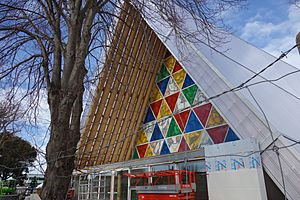
Anglicanism is the largest Christian denomination in Canterbury with 14.8 percent affiliating, while Catholicism is the second-largest with 12.7 percent affiliating.
| Ethnicity | 2006 census | 2013 census | 2018 census | 2023 census | ||||
|---|---|---|---|---|---|---|---|---|
| Number | % | Number | % | Number | % | Number | % | |
| European | 393,219 | 77.4 | 448,650 | 86.9 | 494,340 | 82.4 | 522,498 | 80.3 |
| Māori | 36,669 | 7.2 | 41,910 | 8.1 | 56,298 | 9.4 | 69,060 | 10.6 |
| Pacific peoples | 10,926 | 2.2 | 12,720 | 2.5 | 18,927 | 3.2 | 23,868 | 3.7 |
| Asian | 29,172 | 5.7 | 35,847 | 6.9 | 66,672 | 11.1 | 86,430 | 13.3 |
| Middle Eastern/Latin American/African | 3,363 | 0.7 | 4,374 | 0.8 | 7,314 | 1.2 | 10,299 | 1.6 |
| Other | 70,254 | 13.8 | 10,236 | 2.0 | 8,307 | 1.4 | 8,205 | 1.3 |
| Total people stated | 508,185 | 516,360 | 599,694 | 651,027 | ||||
| Not elsewhere included | 13,650 | 2.6 | 23,076 | 4.3 | 0 | 0.0 | 0 | 0.0 |
Economy
The gross domestic product (GDP) of the Canterbury region was estimated at NZ$44.2 billion in the year to March 2022, representing 12.4% of New Zealand's national GDP. The regional GDP per filled job was $126,733, 4.6% below the national average of $132,815.
For the year ended March 2022, the manufacturing industry was the largest contributor to the Canterbury regional economy, at $4.1 billion. Primary manufacturing (the process of creating a product from raw materials) represented $2.48 billion of the total. Manufacturing industries in the region employed 10.6% of the filled jobs in the region. The construction sector represented the next highest category of regional GDP, at $3.67 billion, followed by professional, scientific and technical services at $3.64 billion.
Agriculture
Agriculture contributed $3.26 billion to the regional economy in the year ended March 2022. The agriculture sector is diversified into dairy farming, sheep farming and horticulture particularly viticulture. The strength of the region's agricultural economy is displayed every November at the Canterbury A&P Show. The show coincides with the regional anniversary day and Cup Week. During the interwar period, agricultural productivity was boosted by the introduction of mechanization, lime and the improvement of seed stocks. Canterbury is also New Zealand's main producer of cereal crops such as wheat, barley and oats. As of 2002, the region produced 60.7% of the nation's supply of wheat, 51.1% of its barley stocks and 43.7% of its supply of oats.
Canterbury has 25,065 hectares of horticultural land, the largest area in New Zealand. The largest crops are potatoes (4,330 ha), peas and beans (2,700 ha), wine grapes (1,770 ha), berries (1,100 ha), and onions (1,000 ha). The region produces half of the New Zealand's mushrooms, nuts and berries.
The region's viticulture industry was established by French settlers in Akaroa. Since then, wine-growing is concentrated into two regions: Waipara and Burnham. Recently, there have been vintages from plantings from Kurow further to the south. White wine has typically predominated in Canterbury from Riesling, Sauvignon blanc, Chardonnay, Gewürztraminer, and to a lesser extent Pinot blanc and Pinot gris. Pinot noir has had some success in the province, particularly in Waipara.
Environment
Like much of the Canterbury-Otago tussock grasslands the Canterbury Plains have been highly modified since human settlement and now support a large agricultural industry. Prior to the arrival of Māori settlers in the 13th century, much of the modern Canterbury region was covered in scrub and beech forests. Forest fires destroyed much of the original forest cover which was succeeded by tussock grassland. By the 19th century, only ten percent of this forest cover remained, and the European settlers introduced several new exotic grass, lupin, pine and macrocarpa that gradually supplanted the native vegetation. Much of the native vegetation was isolated to the alpine zones and Banks Peninsula. From a minimum of about one percent of its original forest cover in circa 1900, the amount of forest on Banks Peninsula has increased.
The amount of dairy farming is increasing with a corresponding increase in demand for water. Water use is now becoming a contentious issue in Canterbury. Lowland rivers and streams are generally polluted and some of the aquifers are being overdrawn. The Central Plains Water scheme is a proposal for water storage that has attracted much controversy. The Canterbury Water Management Strategy is one of the many means being used to address the water issue.
The Canterbury mudfish (kowaro) is an endangered species that is monitored by the Department of Conservation.
Transport
State Highway 1 runs the length of Canterbury, connecting north to Blenheim and the Cook Strait ferry terminal at Picton and south to Oamaru, Dunedin and Invercargill.
Christchurch International Airport, located in Harewood on the northwest outskirts of Christchurch, is the region's main airport. Regular flights operate from Christchurch to most major centres in New Zealand, as well as Australia, the Pacific Islands and eastern Asia. Timaru's Richard Pearse Airport serves South Canterbury with daily flights to Wellington.
Education
Canterbury is served by 292 primary and secondary schools, educating around 94,000 students from ages 5 to 18. Around 13 percent of students attend state-integrated schools and 5 percent attend private schools, with the remaining 82 percent attending state schools. Christchurch and Timaru have single-sex state secondary schools.
Canterbury has two universities: the University of Canterbury located in western Christchurch, and Lincoln University located in Lincoln.
Sport

Sport in Canterbury has developed from the time of the initial settlement by British migrants, and remains an important part of community life. Cricket and rugby union have been popular team sports since the early years of settlement, with the first cricket club established in Christchurch in 1851, and the first rugby club in 1863. Interest in organised sports has diversified and now includes a wide range of codes. In 2022, the top five sporting codes in Canterbury based on club membership were netball, touch rugby, rugby union, golf and cricket.
There are around 1,200 sports clubs and associations in Christchurch, and in 2022 there were 140,000 affiliated members. Most of the sporting codes remain amateur, and rely upon volunteers as administrators and officials. However, there are some professional teams. Notable teams representing Christchurch or the Canterbury region include the Mainland Tactix (netball), Crusaders (rugby) and the Canterbury Kings (cricket).
The Crusaders, who play in the Super Rugby competition, are based in Christchurch. They represent Canterbury and other provinces of the upper South Island. They were formerly known as the Canterbury Crusaders. In provincial rugby, Canterbury is represented by three unions; Canterbury, Mid Canterbury and South Canterbury. For historical reasons, players from Kaikōura District still play for the Marlborough Rugby Union, which is part of the Tasman Provincial team (Nelson/Marlborough Unions combined). Other sporting teams include the Mainland Tactix (netball), Canterbury United FC (football) and Canterbury Rams (basketball).
Christchurch has hosted many international competitions including championship events. A particularly notable international event was the 1974 Commonwealth Games.
There are many outdoor sportsgrounds and a variety of indoor venues. Christchurch City Council maintains 110 sportsgrounds across Christchurch City and Banks Peninsula. The sports venues Lancaster Park and Queen Elizabeth II Park were damaged beyond repair in the 2011 Christchurch earthquake, and were demolished. New facilities built to replace those damaged in the earthquake include the Ngā Puna Wai Sports Hub, the Parakiore Recreation and Sport Centre — an aquatic and indoor sports venue scheduled to open in 2025, and a multi–purpose covered stadium Te Kaha seating 30,000 spectators that is expected to be complete by April 2026.
Film location
Canterbury was the location used in the filming The Lord of the Rings for the fictional city of Edoras, Rohan, on Mount Sunday, as well as Helm's deep backdrop, several miles down the valley.
See also
 In Spanish: Región de Canterbury para niños
In Spanish: Región de Canterbury para niños


